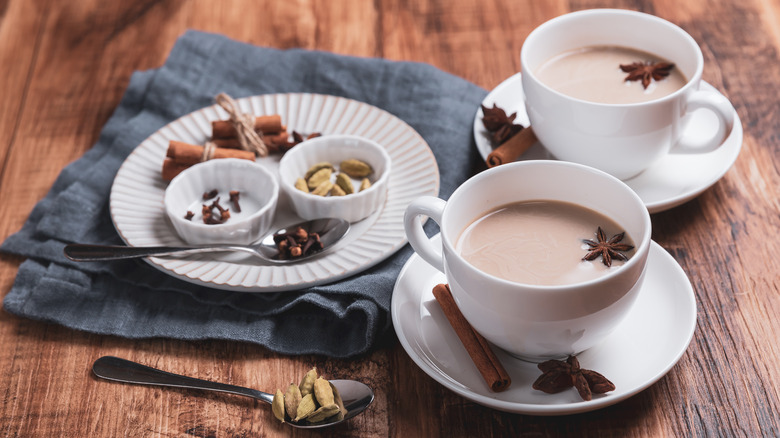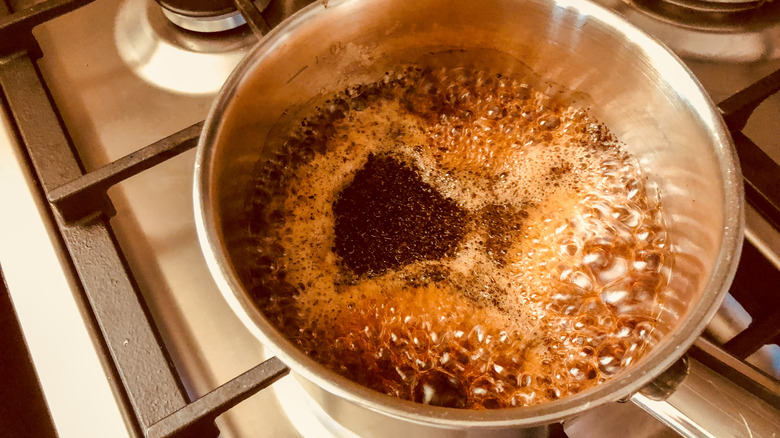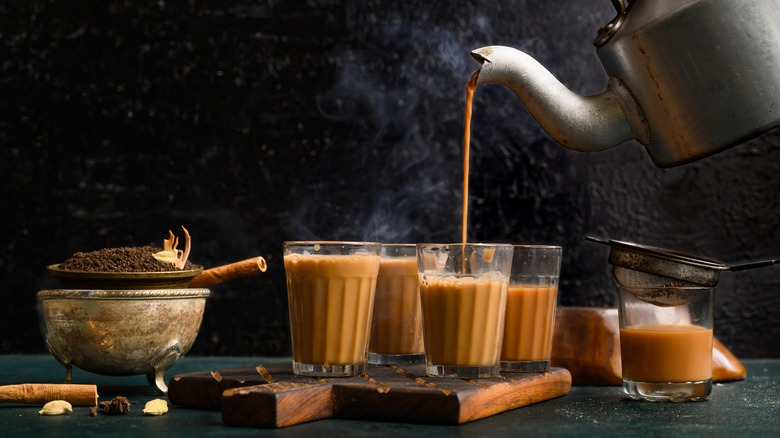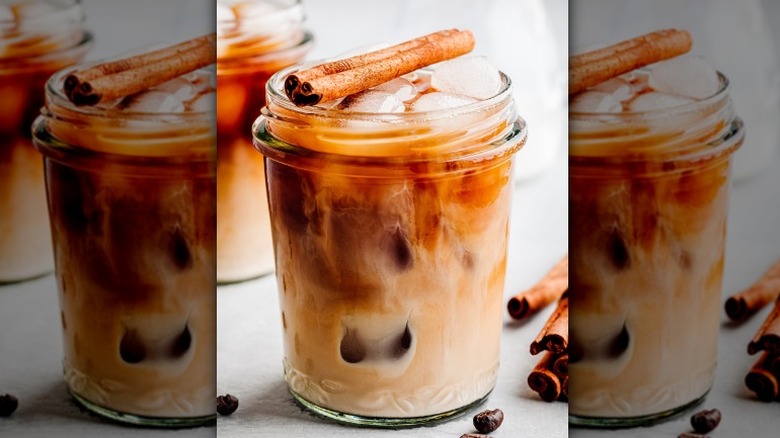What You're Actually Saying When You Order 'Chai Tea' At A Cafe
The South Asian diaspora is incredibly diverse — home to tons of different religions, languages, and ethnicities. Homelands go far beyond the Indian subcontinent to East Africa, Canada, the Caribbean, and everywhere in between. There is, however, something that will evoke a universal eye roll across all South Asians, and that is the (unfortunately ubiquitous) use of the term "chai tea."
Chai literally means tea in Hindi and many other Indian languages, so when you say "chai tea," you're actually saying "tea tea." While this may seem like nothing more than semantics, chai is so quintessential to South Asian culture that saying chai tea, especially when it refers to a beverage that is far removed from its namesake, equates to a kind of erasure. It's not to say that a chai latte from a Western coffee shop can't be delicious. They can be, but it is important to know the roots. If you're a fan of "chai tea," it's also worth seeking out something more traditional to gain an appreciation for what chai can be and where it comes from.
What is the history of tea in India?
The word chai comes from the Mandarin word chá. Though tea did grow wild in areas of India like Assam and was drunk locally, most tea was obtained by way of traders and was used for medicinal purposes. In the 18th century, the British were purchasing huge amounts of tea from the Chinese, the lone tea exporter at the time. To push back on this monopoly, the East India Company established tea plantations in Assam, since this area was already well-suited for growing tea. Assamese locals were skeptical of these foreign interests, and so were unwilling to cut down large swaths of jungle and work the tea fields. Because of their protests and retaliation (and because slavery was outlawed in 1833), the East Indian Company staffed plantations with migrant indentured laborers who were made to work in horrific conditions.
Tea was almost exclusively exported, and the only Indians that drank it were of the upper classes, which was seen as an acceptance of British colonial rule in India. They drank tea the British way, with milk and sugar. By the early 1900s, tea producers turned to local markets to sell off their lower-quality products. In a departure from British standards, masala chai — a milky black tea boiled with spices — took hold of the masses. Tea shops were hubs for social, political, and cultural discourse, especially around the movement for Indian independence. Masala chai became part of an Indian reclamation of identity.
What makes a good cup of chai?
Simply put, chai (known in some regions called chaa) is black tea boiled with milk and sweetened with sugar. Masala chai incorporates spices into the brew and is the most popular version. Every family and chaiwalla — the person running a chai stand — has their own variation.
CTC tea, made from the affordable "crush, tear, curl" processing method, is considered lower quality than whole-leaf varieties. However, Indian innovation took this product and made it into something delectable. Now, CTC black tea (which is what is in most bags of black tea) is essential for a classic chai flavor.
Three qualities constitute good masala chai. First, roughly equal parts water and milk are boiled together with the tea and spices to create a strong brew, cook off the raw taste of the milk, and concentrate flavors. Second, using whole spices ensures a nuanced flavor and aroma. Some crush the spices while others leave them whole. Either way, ground spices are almost never used, as the taste is harsh and the texture unpleasant. Cardamom, ginger, clove, star anise, cinnamon, fennel, coriander, nutmeg, black pepper, saffron, and rose can all be used in any combination. Third, chai must be aerated. At home, this is achieved by allowing the chai to come to a frothy rolling boil before reducing it to a simmer. At chai stands, chaiwallas scoop the chai from a large vat into a smaller pot or ladle and pour it back and forth.
What should chai taste like?
Chai lattes proliferated across Western coffee shops thanks to Starbucks — and a collaboration with Teavana and Oprah Winfrey. Now chai flavor has come to be associated with simply the flavor of warm spices. Chai lattes can include many additions like chocolate, coffee, lavender, and turmeric. Though the flavors were originally inspired by masala chai, they tend to lean heavily on cinnamon and vanilla, and often use a concentrated flavoring syrup. They are typically quite sweet and dairy-forward, as the tea and milk have not been cooked together, and the tea is not strong enough to stand up to the sweetness. They are also often served cold — which is another huge departure from the chai latte's Indian roots.
Indian chai is served steaming hot. While it can be just as sweet as a chai latte, the depth of flavor from the spices and strength of the black tea provides balance. Spices in masala chai should yield a subtle complexity and refined aroma. The milky flavor is caramelized, like the difference between vanilla pudding and whipped cream.




